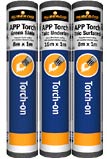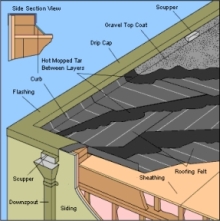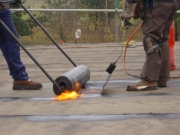
Roofing Felt Information
Although roofing felts of one form or another have probably been with us from time immemorial there is some conjecture where the more recent increase in their use began. One of the more plausible claims points to the Californian gold rush of the 19th century. Small towns and settlements were often established and abandoned very quickly and a need arose for an economic waterproofing material. The result was the invention of 'tar paper'. Tar paper was exactly what it sounds like; paper coated with tar. It was cheap and only lasted for a short time but it did the job!
The destruction of large urban areas of Britain by bombing during the Second World War, slum clearance policies and population growth, created a need for the development of cheap affordable housing. Consequently the 1950s and 1960s saw a proliferation of flat roofed buildings and an expansion in the use of primitive roofing felts.
This period also saw the widespread use of central heating and insulation in residential buildings. It was not fully appreciated at the time that an unventilated roof structure filled with insulation, covered with an impermeable waterproofing membrane, sitting on top of a centrally heated building, would give rise to problems with condensation. The overall result was a disaster, giving flat roofing a bad name from which it still has not fully recovered.

What is Roofing Felt
Roofing felt is made up of two elements. The waterproofing agent (usually bitumen) and the 'carrier' which supports the waterproofing agent. With Tar Paper the waterproofing agent was tar and the carrier was paper.
The Carrier
Paper is not a very durable 'carrier'. It is not very elastic, it tears easily and it will rot if it gets wet.
The surface of a flat roof can suffer huge temperature variations in a single day. It is also prone to movement when the roof structure and the membranes themselves expand and contract because of the weather conditions or as a result of the heating or air conditioning within the building. Just think of the way the weather conditions in Britain can change in the space of a few hours and then consider how this might effect your roof? To cope with these conditions, common to just about every flat roof, more durable carriers were gradually developed.
At first heavier papers were used and hessian. Asbestos was tried and proved quite effective until it was withdrawn on health and environmental grounds. Glass fibre offered an improvement as well but it was brittle and tore easily. It is often used now as an intermediate layer in systems.
The main improvement came with the introduction of polyester. Polyester carriers of a reasonable density are virtually untearable and can cope with the normal movement associated with flat roofs. Polyester carriers come in different weights and this may be referred to with a suffice added after the products description (e.g. polyester 180 or polyester 350… etc). This suffix refers to the weight in grams of a 10 x 10cm sample of the polyester used.
The Waterproofing Agent
Originally any type of paint or tar was used as a waterproofing agent. As roofing felts were developed bitumen was identified as a suitable material. Ordinary bitumen (or oxidised bitumen) is a heavy black solid material, which becomes very brittle in cold temperatures. This makes it susceptible to cracking and failure in low temperatures. In its early life some flexibility is provided by the oil within the product. However, as these oils evaporate over time the bitumen becomes more and more brittle.
By adding different chemicals to oxidised bitumen it was found that its performance characteristics could be greatly enhanced. Two additives are commonly used for this purpose, either 'actactic polypropylene' (APP) or 'styrene butadiene styradene' (SBS). Roofing felts which are manufactured with modified bitumen are sometimes called 'high tensile' or 'HT' (e.g. HT180).

Application - Roll & Pour Torchon
Felt flat roofing systems are made from a build up of several layers of roofing felt. These layers are usually stuck together with molten liquid bitumen. Cold bonding agents are some times used but, with a very few exceptions, these are generally primitive and less reliable.
Two methods of applying roofing felt have been developed. These are usually called, 'roll and pour' or 'torchon' . In the former case the bitumen is heated in a separate boiler and poured out onto the roof. Rolls of roofing felt are then rolled out into the hot liquid. 'Torchon' roofing felts are manufactured with additional bitumen on the back. This is heated with a gas torch. As it melts the felt is rolled out across the roof. Each method has it's own advantages and benefits depending on the type of roof, access and other considerations.
Finishing Layers - Surface Protection
Whatever roofing felt system is used, consideration must be given to protecting the surface of the system from direct sunlight and extreme cold.
Sunlight is the main enemy of roofing felt systems. It has the following detrimental effects:-
- It dries out the oils in the system and make it become brittle
- Ultra violet light breaks down oxidised bitumen and SBS
- Heat causes expansion and movement which puts the roofing felt under stress
Some of the more common forms of surface protection are as follows:
White limestone chippings
The older roofing felt systems were so poor that they had to be overlaid with stone Chipping's which provide very good protection. They have an additional benefit of ballasting the roof and reducing wind up lift. However, they are unsightly and have a tendency to be washed off which can block gutters and drainage. They attract debris and plant growth. They are heavy and labour intensive to apply.
Solar reflective paint
Solar reflective paint is probably the least effective method. The paint will fade over time and typically requires re-painting every three to five years. This creates an ongoing maintenance liability, which is easily overlooked. Failure to re-coat the surface can lead to premature failure.
Mineralised surface (or cap) sheet
With more advanced systems and especially with APP modified roofing felts (APP is not affected by ultra violet) very little protection is required. A mineralised cap sheet offers an attractive, maintenance free option.
Physical protection
Physical protection is the ultimate option(e.g. roof garden, walkway tiles, 'upside-down roof'). It will completely protect the roof from any light and also insulate it from snow, frost and wind chill. The use of a covering sheet manufactured using APP bitumen which is resistant to ultra violet degradation. A simple and effective solution to ultra violet problems. However, it does not deal with the other problems and the finish is rather ugly.
Insulation - Warm Roof
Re-roofing often provides a good opportunity to insulate. With flat roofs one of the most efficient ways of doing this is to use a dense insulation board sandwiched between the layers of the roofing system. This has three benefits:
- It improves the environment within the building
- It keeps the roof structure 'warm' and reduces expansion and contraction which extends the life of the new roof system
- It prevents condensation forming in the roof void which could otherwise cause timber decay and also blisters in the roofing felt which would lead to failure
Warm roofs do not need to be ventilated.
Lead Flashings
The roof structure and masonry walls around the perimeter, expand and contract at different rates, thereby pulling and pushing the waterproofing materials in different directions and at different rates.
If a lead flashing is used it can be draped down over the top of the roofing felt upstand and, because it is not joined to the roofing felt, it will allow both structures to move without risk of failure.
Work Guarantee
All work undertaken by C. Stevens Roofing is covered by clear, written guarantees including workmanship and material, to give you added confidence. Our guarantee is backed by a long established reputation in the business and is respected and valued by works professionals throughout the county.
Insurance Guarantee

HomePro Insurance Backed Guarantees helping you to protect your investment. Although home improvement is one of the safest forms of financial investment, there is one pitfall that can be overlooked.
Most contractors issue a guarantee for the work they have undertaken, we are no different. However, thousands of contractors cease to trade each year.
If your chosen contractor ceased to trade HomePro will match the terms of the contractors original guarantee.
